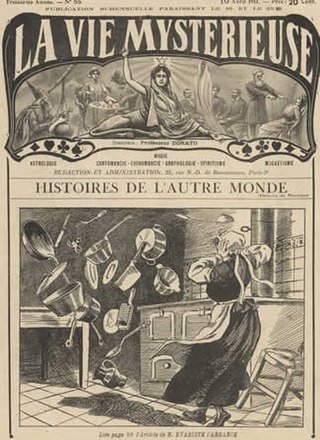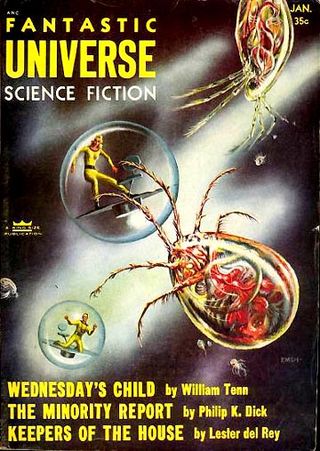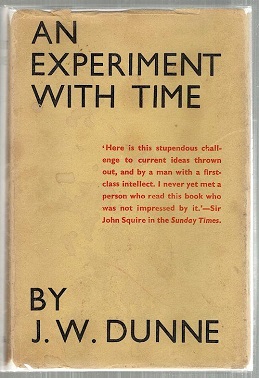Related Research Articles
Extrasensory perception or ESP, also called sixth sense, is a claimed paranormal ability pertaining to reception of information not gained through the recognized physical senses, but sensed with the mind. The term was adopted by Duke University botanist J. B. Rhine to denote psychic abilities such as intuition, telepathy, psychometry, clairvoyance, clairaudience, clairsentience, empathy and their trans-temporal operation as precognition or retrocognition.

In German folklore and ghostlore, a poltergeist is a type of ghost or spirit that is responsible for physical disturbances, such as loud noises and objects being moved or destroyed. Most claims or fictional descriptions of poltergeists show them as being capable of pinching, biting, hitting, and tripping people. They are also depicted as capable of the movement or levitation of objects such as furniture and cutlery, or noises such as knocking on doors. Foul smells are also associated with poltergeist occurrences, as well as spontaneous fires and different electrical issues such as flickering lights.
Precognition is the purported psychic phenomenon of seeing, or otherwise becoming directly aware of, events in the future.

A psychic is a person who claims to use extrasensory perception (ESP) to identify information hidden from the normal senses, particularly involving telepathy or clairvoyance, or who performs acts that are apparently inexplicable by natural laws, such as psychokinesis or teleportation. Although many people believe in psychic abilities, the scientific consensus is that there is no proof of the existence of such powers, and describes the practice as pseudoscience. The word "psychic" is also used as an adjective to describe such abilities.

"The Minority Report" is a 1956 science fiction novella by American writer Philip K. Dick, first published in Fantastic Universe. In a future society, three mutants foresee all crime before it occurs. Plugged into a great machine, these "precogs" allow a division of the police called Precrime to arrest suspects before they can commit any actual crimes. When the head of Precrime, John Anderton, is himself predicted to murder a man whom he has never heard of, Anderton is convinced a great conspiracy is afoot.

An omen is a phenomenon that is believed to foretell the future, often signifying the advent of change. It was commonly believed in ancient times, and still believed by some today, that omens bring divine messages from the gods.

A prediction or forecast is a statement about a future event or about future data. Predictions are often, but not always, based upon experience or knowledge of forecasters. There is no universal agreement about the exact difference between "prediction" and "estimation"; different authors and disciplines ascribe different connotations.
A psychic detective is a person who investigates crimes by using purported paranormal psychic abilities. Examples have included postcognition, psychometry, telepathy, dowsing, clairvoyance, and remote viewing. In murder cases, psychic detectives may purport to be in communication with the spirits of the murder victims.

Sylvia Celeste Browne was an American writer, medium, and psychic. She appeared regularly on television and radio, including on The Montel Williams Show and Larry King Live, and hosted an hour-long online radio show on Hay House Radio.

The Aberfan disaster was the catastrophic collapse of a colliery spoil tip on 21 October 1966. The tip had been created on a mountain slope above the Welsh village of Aberfan, near Merthyr Tydfil, and overlaid a natural spring. Heavy rain led to a build-up of water within the tip which caused it to suddenly slide downhill as a slurry, killing 116 children and 28 adults as it engulfed Pantglas Junior School and a row of houses. The tip was the responsibility of the National Coal Board (NCB), and the subsequent inquiry placed the blame for the disaster on the organisation and nine named employees.

An Experiment with Time is a book by the British soldier, aeronautical engineer and philosopher J. W. Dunne (1875–1949) about his precognitive dreams and a theory of time which he later called "Serialism". First published in March 1927, the book was widely read. Although never accepted by mainstream scientists or philosophers, it has influenced imaginative literature ever since. Dunne published four sequels: The Serial Universe, The New Immortality, Nothing Dies and Intrusions?

Vangeliya Pandeva Gushterova, commonly known as Baba Vanga, was a Bulgarian attributed mystic and healer who claimed to have foreseen the future. Blind since her early childhood, she spent most of her life in the Rupite area of the Belasica mountains in Bulgaria.

The Flatwoods monster, in West Virginia folklore, is a creature reported to have been sighted in the town of Flatwoods in Braxton County, West Virginia, United States, on September 12, 1952, after a bright light crossed the night sky. Over 50 years later, investigators suggest the light was a meteor and the creature was a barn owl perched in a tree with shadows making it appear to be a large humanoid.
Joe Nickell is an American skeptic and investigator of the paranormal.
Peter Fairley was a British science journalist who was the Science Editor for Independent Television News and TV Times magazine the late sixties and early seventies. His name became synonymous with ITN's extensive live coverage of the Apollo Moon landing missions.
Richard J. Wiseman is a professor of the public understanding of psychology at the University of Hertfordshire in the United Kingdom. He has written several psychology books. He has given keynote addresses to The Royal Society, The Swiss Economic Forum, Google and Amazon. He is a fellow for the Committee for Skeptical Inquiry and a patron of Humanists UK. Wiseman is also the creator of the YouTube channels Quirkology and In59Seconds.
In West Virginian folklore, the Mothman is a humanoid creature reportedly seen in the Point Pleasant area from November 15, 1966, to December 15, 1967. The first newspaper report was published in the Point Pleasant Register, dated November 16, 1966, titled "Couples See Man-Sized Bird ... Creature ... Something". The national press soon picked up the reports and helped spread the story across the United States. The source of the legend is believed to have originated from sightings of out-of-migration sandhill cranes or herons.
In psychology, anomalistic psychology is the study of human behaviour and experience connected with what is often called the paranormal, with few assumptions made about the validity of the reported phenomena.

Deathbed phenomena refers to a range of experiences reported by people who are dying. There are many examples of deathbed phenomena in both non-fiction and fictional literature, which suggests that these occurrences have been noted by cultures around the world for centuries, although scientific study of them is relatively recent. In scientific literature such experiences have been referred to as death-related sensory experiences (DRSE). Dying patients have reported to staff working in hospices they have experienced comforting visions.
References
- 1 2 3 Akers, W.M. "Harnessing ESP to Forestall Death and Disaster". The New York Times. Retrieved 26 April 2023.
- ↑ Masad, Ilana. "The 'Premonitions Bureau' considers whether some can sense future events". NPR. Retrieved 26 April 2023.
- 1 2 3 4 Wiseman, Richard. "A data bank for the nation's dreams and visions". The Psychologist. The British Psychological Society. Retrieved 26 April 2023.
- 1 2 3 Altschuler, Glenn. "The Power of Premonitions". Psychology Today. Retrieved 26 April 2023.
- 1 2 3 4 5 McConnachie, James. "The Premonitions Bureau review: A 1960s hunt for paranormal powers". The New Scientist. New Scientist Ltd. Retrieved 26 April 2023.
- 1 2 3 4 5 6 Wiseman, Richard (2010). Paranormality : why we see what isn't there. London: Spin Solutions Ltd. pp. 145–150. ISBN 978-0-9568756-5-5.
- 1 2 3 4 5 6 7 Knight, Sam. "The Psychiatrist Who Believed People Could Tell The Future". The New Yorker. Retrieved 26 April 2023.
- 1 2 Nickell, Joe. "Premonition! Foreseeing What Cannot Be Seen". Skeptical Inquirer. Center For Inquiry. Retrieved 26 April 2023.
- ↑ Tait, Amelia. "I knew that was going to happen... The truth about premonitions". The Guardian. Retrieved 26 April 2023.
- ↑ Mansfield, Katie. "Faber snaps up Sam Knight non-fiction as Amazon triumphs in 19-way auction for screen rights". The Bookseller. The Stage Media Company Ltd. Retrieved 28 April 2023.